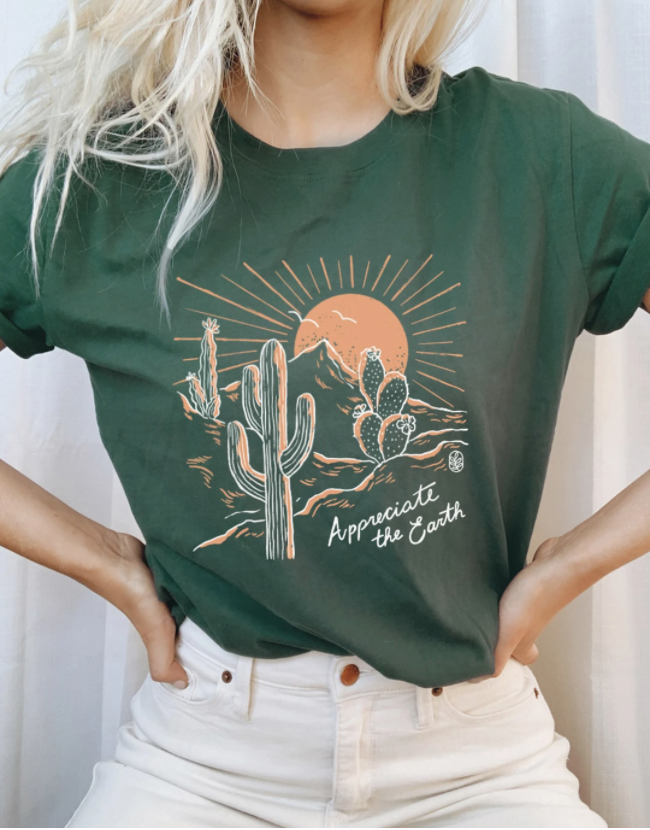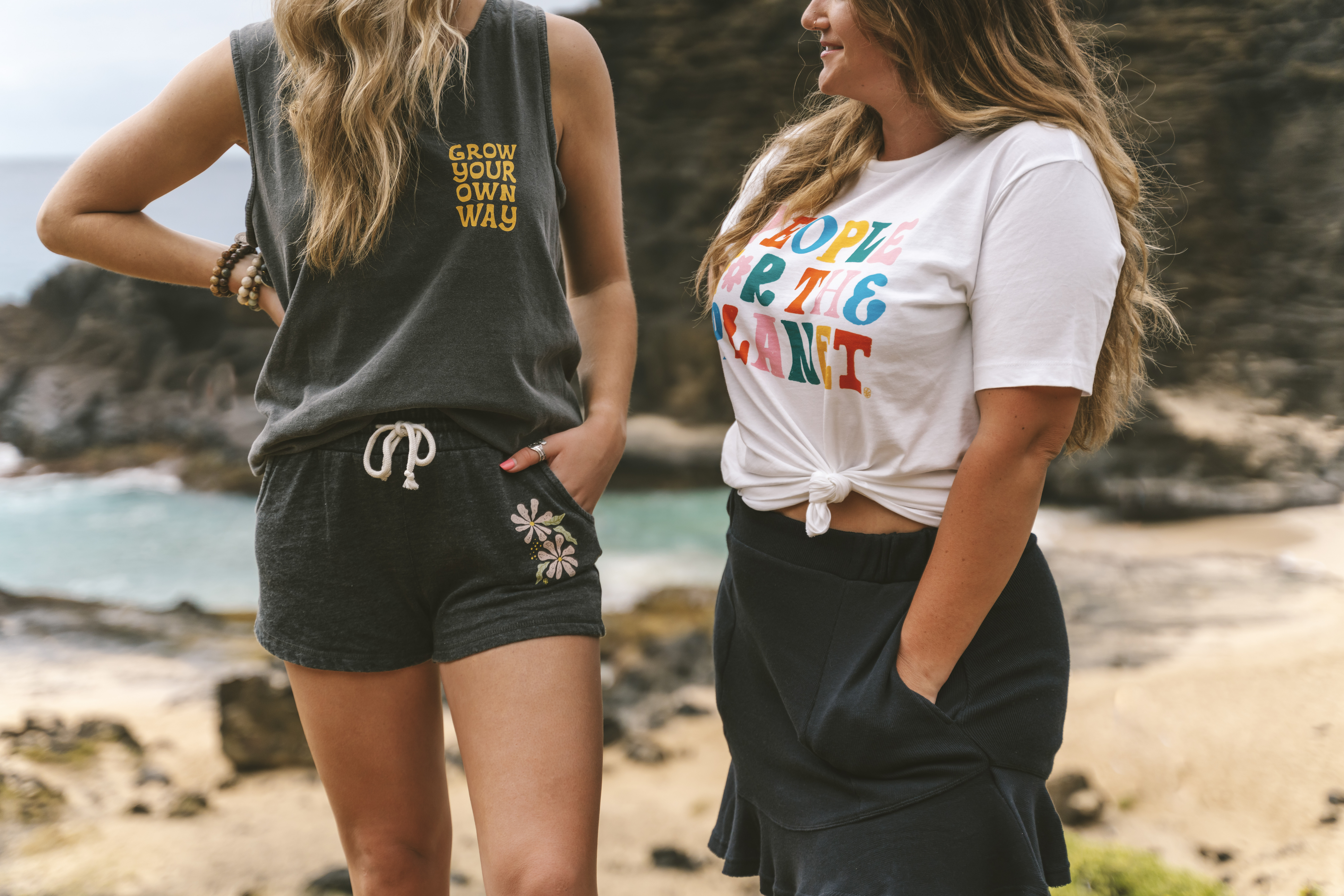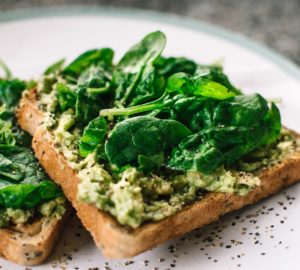Green Glossary: Your go-to guide to navigating eco terms
With so many eco terms circulating around the green movement, it can be a challenge figuring out what’s what. Between compostable & biodegradable, sustainable & regenerative — there’s a lot of interchangeability and room for confusion.
While some of the below terms do not have strict legal definitions, we’re breaking down the words to give you a general idea of how to navigate eco terms and help you hone in on subtle differences. And if you’re reading this, we’re giving you a digital high-five because it shows you care about what you’re supporting (go you!). Here’s your go-to guide to eco-terms:
Green Glossary: Your Go-To Guide to Eco Terms
Compostable vs. Biodegradable
If something is compostable that means the material can break down fully and release nutrients back into the soil. Generally, this process takes anywhere from 90 days to a couple of years depending on the environment. So while composting requires patience, it’s well worth it because the practice not only saves the landfill from unnecessary waste, but it also decreases greenhouse gases. Plus, it creates *free* nutrient-rich fertilizer for your yard or a friend’s!
Examples of compostable material include:
- Banana peels
- Fruit cores
- Coffee grounds
- Newspapers
- Veggie skins
- Eggshells (but not the eggs!)
- Nutshells
View this post on InstagramA post shared by Earth Packaging Co (@earthpackagingco) on
On the other hand, biodegradable materials can eventually return to the environment rather than clogging landfills. However, the time frame is less definite compared to compostable materials. In some cases, such as many biodegradable plastic cups, biodegradable materials may breakdown as slowly as the regular kind.
To sum it up, all compostable materials are biodegradable, but not all biodegradable materials are compostable. It’s complicated, we know! That said, both compostable and biodegradable materials need the right conditions to properly breakdown. Check out our full guide to composting, here.
Carbon Footprint vs. Ecological Footprint
A carbon footprint is the total amount of greenhouse gases generated by human actions. Typically, a carbon footprint comes from food, housing, and transportation. As you’d probably assume, the lower your carbon footprint is, the gentler your impact is on the planet. (Eating a more plant-based diet, walking instead of driving, and taking shorter showers are three simple ways to cut your carbon footprint.)
An ecological footprint is a more holistic approach to analyzing how much pressure humans are putting on nature and the amount of nature needed to support humans. According to FootprintNetwork.org, humans use ecological resources as if we lived on 1.6 Earths. (Not ideal to say the least.)
Both terms relate to human impact on the Earth, however, a carbon footprint is specific to greenhouse gases while an ecological footprint considers the demand for food and fiber, energy production, space for roads and shelters, etc.
Zero-Waste vs. Plastic-Free
The idea of zero-waste is sending as little as possible to the landfill through practices like reusing, recycling, and, most of all, reducing and refusing. Whereas living plastic-free involves slashing plastic specifically.
View this post on InstagramA post shared by Wholesome Culture (@wholesomeculture) on
Overlap with the terms is common. For example, a reusable ceramic mug is both plastic-free and zero-waste. However, throwing out a bunch of plastic containers to go “plastic-free” and then replacing them with glass containers is certainly not zero-waste. Rather, a zero-waster would attempt to use the plastic containers until they’re no longer usable and also try to give them a second life before recycling them properly. It’s a subtle yet important difference!
Check out these posts for inspiration on how to embrace a more zero-waste lifestyle:
- 10 easy ways to introduce zero-waste into your lifestyle
- How to reuse 5 everyday items like a boss
- 16 awesome gift ideas for people going zero-waste
Plant-Based vs. Vegan
Being vegan is the exclusion of all animal-derived products from one’s lifestyle — from the kitchen to the closet. This means one doesn’t eat eggs, meat, fish, poultry, cheese, or dairy products. Instead, a vegan diet consists primarily of fruits, veggies, nuts, grains, seeds, and legumes. Similarly, a vegan won’t buy anything with leather, suede, & wool, and will not support any products that are involved with animal testing.
Although plant-based and vegan are often used interchangeably, typically, a plant-based eater focuses on consuming foods primarily from plants but *may* also eat meat/dairy. Of course, a plant-based eater may not eat any animal-derived products and also very well can identify as a vegan. But attempting to eat more fruits and vegetables, and embracing Meatless Monday are certainly components of a plant-based forward lifestyle (at least in our opinion at Wholesome Culture!).
If you’re curious about why a plant-based lifestyle is beneficial for Mother Earth, we answered this question in a previous post: How Eating Plant-Based Helps the Environment
Sustainable Fashion vs. Regenerative Fashion
A textbook definition of sustainable is, “using a resource so that the resource is not depleted or permanently damaged.” We like to think of sustainability as embracing practices that do not harm the environment and aiming to be as gentle on Mother Earth as possible. (Learn more about how our clothes are made with sustainability in mind: here.)
So what does “regenerative” mean? In terms of the fashion industry, Vogue describes regenerative fashion as the practice of farming that both omits chemics and replenishes the natural environment. In this sense, regenerative fashion, like sustainable fashion, aims to not aggravate nature but also works to help heal the planet. (Think: pesticide-free, pollinator-friendly farms.)
Organic vs. Non-GMO
According to the USDA, organic producers “rely on natural substances and physical, mechanical, or biologically based farming methods to the fullest extent possible.” So, if something is USDA-certified organic that generally means it is grown without the use of synthetic fertilizers/pesticides/GMOs. That said, exceptions are permitted when organic alternatives aren’t available. Also, there are rules around the humane treatment of animals + standards related to pest/weed management for something to be certified organic.
Non-GMO, on the other hand, means that a third-party certification has verified that no GMO ingredients are in a product. But, Non-GMO doesn’t mean the product is necessarily grown organically.

PS, if you’re looking to embrace organic materials in your wardrobe, be sure to check out our Wholesome Culture Organic Collection. 🌿
Non-toxic vs. Natural
Non-toxic generally means that a product doesn’t contain poisonous or toxic materials that harm Earth or human health. We still recommend looking at the ingredients list, but “non-toxic” is generally a good sign that ingredients like formaldehyde, parabens, and petroleum aren’t in the product.
These two words are on the hazier side. Regarding natural, generally, the FDA considers it to mean that nothing artificial or synthetic has been included/added to a food that wouldn’t “normally be expected to be in that food.” However, “natural” is more of an unregulated term and, like always, we’d recommend looking at the ingredient list to make sure you’re empowered with as much information as possible.
One of the surest ways to make sure you’re comfortable with what you’re using is to make it yourself. Check out these DIY posts for homemade inspiration:
- DIY Self-care ideas for an at-home spa day
- 11 Planet-friendly ways to clean your home
- How to get an eco-friendly skincare routine








